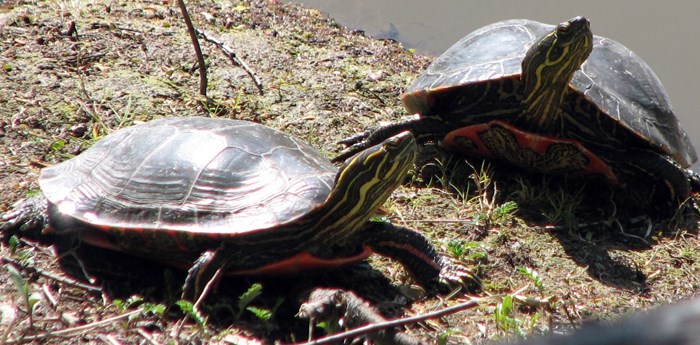While many people may not be aware, Saskatchewan is home to native turtles.
“A lot of people are skeptical … are not even aware they are here,” Kelsey Marchand with the University if Regina told those attending the Saskatchewan Wildlife Federation Convention held in Yorkton last week.
There are actually two species in the province.
The first is the snapping turtle.
“It’s a beautiful, beautiful species,” said Marchand, but she added they do have a limited range in Saskatchewan. “They’re normally found in the southeast portion of the province. They’re not very widespread.”
The second species is the western painted turtle, generally recognizable by its head markings.
“It has very beautiful yellow stripes down the side of the head,” said Marchand.
The under belly design on the painted turtle is also quite dynamic and unique to the specific turtle.
The western-painted turtle can be mistaken for a non-native species which does pop up in the wild, the red-eared slider. The sliders are your common pet turtle, and they do show up in the wild, particularly in urban areas, said Marchand.
“People think they’re going to be a cute pet, but they grow to the size of a dinner plate,” she said, so at times owners simply release the pet turtles into the wild.
In her work within the urban setting of Regina Marchand said she found six sliders which had been let go, adding in Ontario and Vancouver significant populations of the red-eared sliders are occurring.
That is a concern to indigenous species because the pet store turtles can carry diseases which native species have no natural defence too, said Marchand.
As for the western painted turtle Marchand said there are “a lot of knowledge gaps” regarding the species in Saskatchewan.
That is the reason for her current study work in Regina, beginning to collect some much-needed data.
“You need to get that baseline information before problems start,” he said.
Marchand’s study is focused in Regina, which might surprise some, but she said “there’s a wide variety of habitat within an urban setting.”
The actual project began in May, with Marchand finding, and tagging 61 western painted turtles, 38 females, 19 males and four juveniles.
“The females are much larger than males,” she noted, explaining they need the larger body size in order to carry eggs.
And during the tagging Marchand happened upon the largest western painted turtle “ever recorded in literature,” wishing in at 2,670 grams.
“This female, she’s a beauty … She’s a very big gal,” she said as a slide picture was shown to those attending the session.
For those seeing a painted turtle in the wild, “males are sort of like wolverines. They have long nails,” said Marchand, adding they use the claws to “tickle the face” of protective female mates.
Once tagged, Marchand was able to track movements in order to ascertain “what habitats they are using” and when.
For example, eggs are laid and buried in the ground.
A female will typically lay 15 to 20 eggs, but often no young hatch as nests are predated by racoons, foxes, ravens, and even ground squirrels.
Marchand said ideally the female lays eggs on a rainy night, as the moisture lessens her scent and thus the ability of predators to find the nest.
As it is, for a female to lay an egg, have that egg hatch, and the baby turtle to reach adulthood to replace her in a population can take 25 years of laying a clutch.
In the winter the turtles rest in the mud under the ice, a spot such as Wascana Marsh where a number of the tagged turtles now reside, all some seven-metres from shore.
Ideally they are able to extract oxygen from the water, but in low oxygen conditions, like the marsh this year, the turtle slows it’s metabolisms. This causes a buildup of gas, much like an athlete has lactic acid after working out, but a mechanism which utilizes the shell helps the turtle deal with the gas build up, said Marchand.
“So turtles are really freaking cool,” she said.
The project to track turtles is ongoing, and Marchand said she can use help in that effort.
“Keep an eye out for turtles,” she encouraged, asking the SWF members and others to send reports of sightings to turtles@royalsaskmusuem.ca
The reports and her collected data will go to establish a report “on where turtles are in the province,” she said. “… We’ll compile all the data into a nice little database.”



